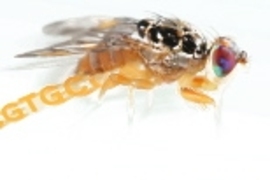In work that reveals important clues in the evolution of genes, an international consortium of MIT scientists and colleagues has analyzed the genomes of twelve species of the fruit fly Drosophila in one of the first large-scale comparisons of multiple animal genomes.
The researchers' approach may also help unlock the secrets of other genomes, including our own.
The work appears in the Nov. 8 issue of Nature and in more than 40 accompanying papers in Genome Research and other journals.
Â
"Having the sequences of many closely related species allows us to study the evolutionary forces that have shaped the fruit fly's family tree, and to discover the working parts of the fly genome in a systematic way," said Manolis Kellis, associate member of the Broad Institute of MIT and Harvard and one of the project leaders. Kellis is also the Karl Van Tassel Career Development Assistant Professor of Electrical Engineering and Computer Science at MIT, and is affiliated with the Institute's Computer Science and Artificial Intelligence Laboratory.
On one hand, the researchers studied the differences across species to help elucidate how evolution has shaped fly biology over millions of years. Their analysis revealed that while many attributes of Drosophila genomes are in fact conserved across multiple species, each species has novel features not seen in any other. For example, the genes involved in interactions with the environment and in reproduction showed signs of adaptive evolution, meaning that they likely provided some survival advantage to the organism.
Â
On the other hand, the researchers studied the similarities of the different species to help define the functional parts of the fly genome. The parts of a genome that are unchanged (conserved) are those that have been kept by evolution, and are thus likely to play crucial roles. Thus, genome comparison can reveal which regions of the genome are functional, based on the degree to which evolution has conserved them.
Â
"Focusing on the conserved part of the genome is a great way to discover what has been maintained by evolution," said Kellis. "Moreover, by looking more closely at the subtle patterns of mutation within conserved regions, we can predict the functional roles they play."
Â
Indeed, at the level of DNA, several combinations of letters, or nucleotides, may encode the same function, in the way that a storyteller can use different combinations of words to tell the same tale. For example, four different nucleotide combinations--GTT, GTC, GTA and GTG--all encode the same protein building block, or amino acid. Thus, a change in the third letter would leave the amino acid unchanged, one example of how DNA changes can be tolerated while still preserving the function of the corresponding protein.
Â
Through these kinds of random mutations, evolution explores the possible nucleotide combinations that preserve function. This exploration produces unique patterns of genomic change, described by the researchers as "evolutionary signatures" that are specific to the function of that region of DNA.
Â
Kellis and colleagues identified evolutionary signatures associated with a variety of roles in the genome such as protein-coding genes. The researchers then used these evolutionary signatures to systematically identify the functional elements encoded in the fly genome, leading to hundreds of novel functional elements and many new insights on animal biology.
The team's analysis is the first time that such a diverse range of evolutionary signatures has been applied to identify the functional elements of a genome in a comprehensive way. "By comparing many closely related genomes, we were able to discover things we never thought were possible using one genome sequence alone," said Kellis.
One intriguing possibility is that evolutionary signatures may even identify novel, yet unknown classes of functions. For example, although the fruit fly has been intensely studied for over a century, microRNAs were only discovered in the last decade, and are now known to play a central role in development. Many other classes of yet unknown functional elements may be hidden in the fly genome, and recognition of their common evolutionary properties may help lead to their discovery.
Â
The study of the 12 flies has immediate implications for the discovery of functional elements in the human genome. "We are now using similar methods to analyze 32 mammalian genomes, in order to help understand the human genome," Kellis explained. "We should be able to apply the methodology of evolutionary signatures to any group of closely related species."
Â
The Broad Institute of MIT and Harvard was one of several sequencing centers to participate in the work, in addition to Agencourt Bioscience Corporation, the Washington University Genome Sequencing Center and the J. Craig Venter Institute.Â
A version of this article appeared in MIT Tech Talk on November 14, 2007 (download PDF).







